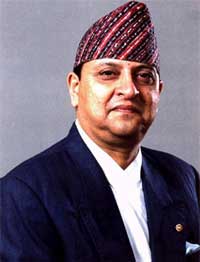 His Majesty's interview [last week] was well planned and thought-out. The interview was organised to portray His Majesty's views one year after his ascension to the throne. Sources told us that because an interview with the Rastriya Samachar Samiti (RSS) would reach all newspapers, it was first asked to submit the questions. The chairman and general manager of the RSS, Purushottam Dahal, had put forward the questions. After that, though, it was decided that an interview on television would be more effective and would also be useful in portraying His Majesty's personality and voice, and so it was decided to grant interviews to both state-run media [print and television].
His Majesty's interview [last week] was well planned and thought-out. The interview was organised to portray His Majesty's views one year after his ascension to the throne. Sources told us that because an interview with the Rastriya Samachar Samiti (RSS) would reach all newspapers, it was first asked to submit the questions. The chairman and general manager of the RSS, Purushottam Dahal, had put forward the questions. After that, though, it was decided that an interview on television would be more effective and would also be useful in portraying His Majesty's personality and voice, and so it was decided to grant interviews to both state-run media [print and television]. Prior to this, because His Majesty had granted audiences only to journalists from the private sector press, and there had been comments about that. It was for that reason that Durga Nath Sharma, general manager of NTV had to submit his questions for the television interview beforehand. After both parties had submitted written questions, some similar questions in both were retained, and some different questions were also included. For example, one set kept the query on SAARC and the other on Bhutan. The general managers were also permitted to ask a few follow-up questions. The interview was recorded on 3 June. The previous day, NTV technicians were taken to Mangal Sadan to arrange the technical aspects-chairs, tables, lighting in a way "that would be good." The television interview was recorded at 4PM, and lasted for about an hour. Dahal was called in for his audience after that. His Majesty's secretaries had advised [Dahal and Sharma] on when the interviews should be published or broadcast, and how. Dahal and Sharma both sent their final manuscript and tape to the palace for the final approval, and what came back to them was put out for public consumption. The prime minister had also been informed that His Majesty was granting interviews to NTV and RSS. Both interviews were non-controversial.
His Majesty's views were relevant and serious. The questions ranged from issues relating to the time when His Majesty was briefly on the throne in 1950 to the recent dissolution of the parliament. The interviews also included questions on nationalism, monarchy, democracy, good governance, terrorism, SAARC, Bhutan, and economic development, among others. There were no unnecessary or controversial answers. His Majesty's voice, personality and presentation were also effective. It was evident that His Majesty wanted to answer each of the questions briefly and with the use of symbols. Those journalists who have met the king in the past and those who have studied the published material attributed to His Majesty had expected him to be clearer and more open. Instead of open discussions between His Majesty and the interviewers, there was plenty of formality. As a result, it is being assumed that many questions that are on the people's minds might have been excluded, as the formality hinted at the greater influence of overly traditional officials.


